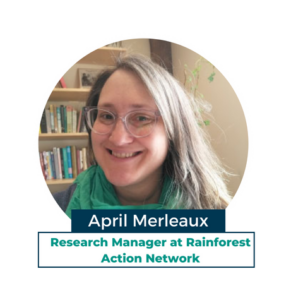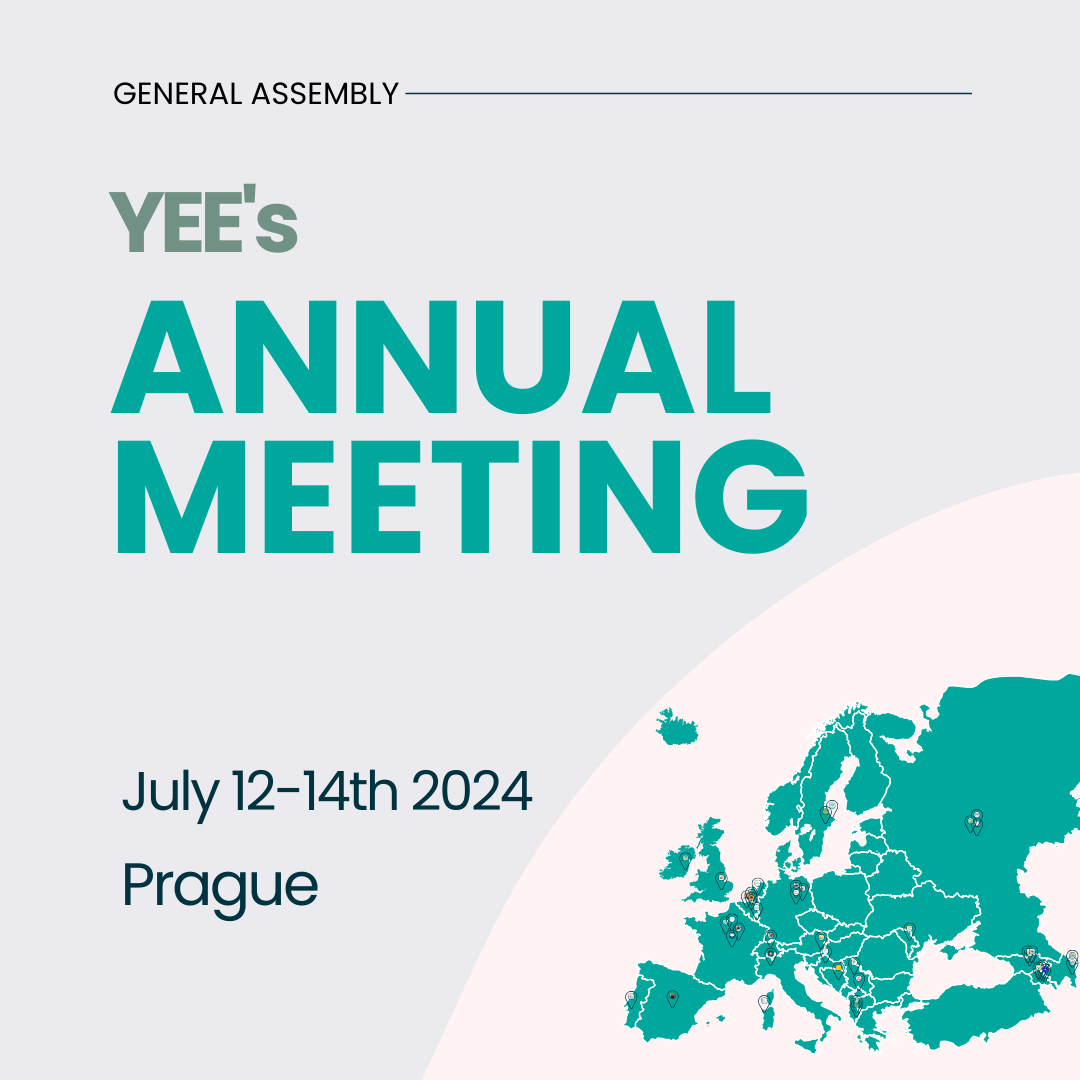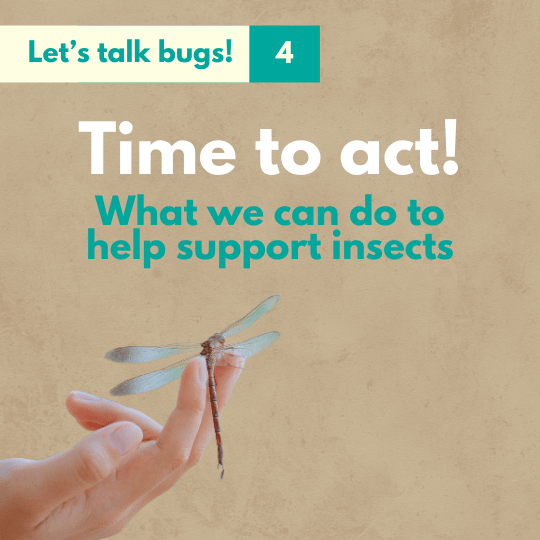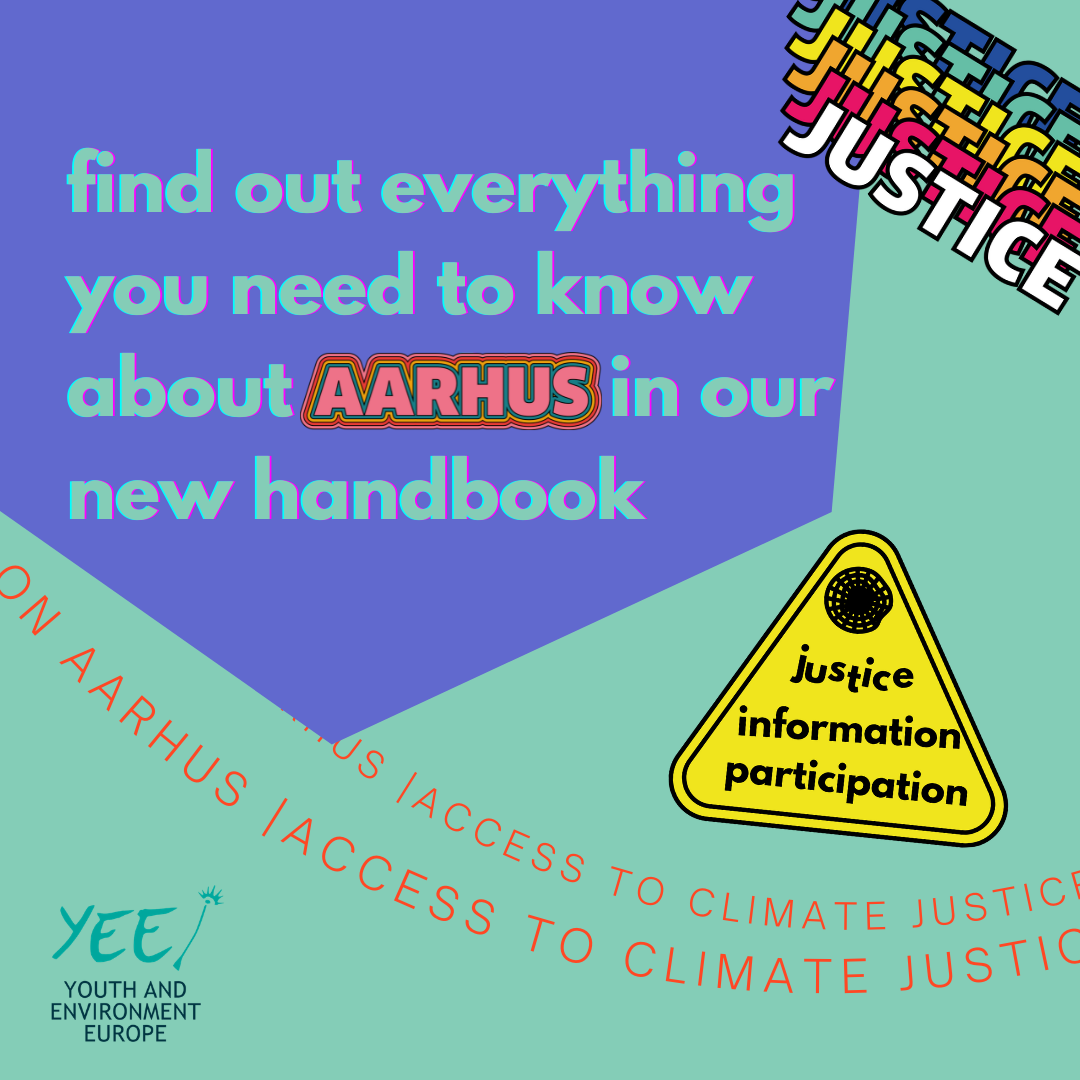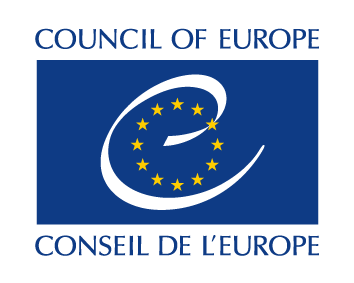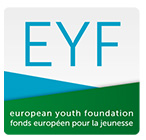Practical information
-
When
Friday 2nd June 2023 at 18h CEST
-
Where
Online
-
How
Register your interest
Share This Event
Together with April Merleaux (co-author of the Banking on Climate Chaos Report) and Noam-Pierre Werlé from Reclaim Finance, we will discuss the relation of mutual interdependence between financial institutions and the fossil fuel industry. We will also analyze in what ways this relation can be leveraged to discourage future fossil fuel production.
The aim of the webinar is to:
- explore the relationship between the banking system and the fossil fuel industry
- investigate the accountability of banks for the emissions of fossil fuel companies
- explore the main initiatives undertaken at the European level to encourage investment in more sustainable industries
Meet the speakers:
Have questions? Get in touch!
Other upcoming events
A lot of finance is still not Green | Webinar
https://yeenet.eu/wp-content/uploads/2023/05/Webinar-Energy-Policy-Instagram-Post-Square10.png 540 540 YEE https://yeenet.eu/wp-content/uploads/2018/11/logo-yee-728x1030.png YEE2023-05-24 12:02:102023-06-12 17:52:56A lot of finance is still not Green | WebinarAdvocating for stronger legal protection of rivers in Europe
Why up to 60% of European water bodies are highly polluted?

Rivers – anywhere you are in Europe, there must be a river not far from you. Ancient Greeks would marvel at rivers like Gods. How have we now come to a point in which up to 60% of European water bodies (including rivers) are highly polluted?
River Health
The health of water bodies constitutes a major determinant for human food and water quality, which demonstrates how human health is inextricably tied to healthy water body habitats. Rivers, in particular, constitute mobile water bodies which cross vast swathes of Europe while exchanging water, materials, energy and nutrients with their surroundings. Therefore, even though they make up a small percentage of surface freshwater, they have a significant influence on European habitats and their conservation status.
Pollution
Like other surface water bodies, rivers are affected by multiple sources. Point source pollution for example is any identifiable source of pollution, such as wastewater. Its disposal in rivers leads to a high concentration of toxic chemicals, such as cyanide, zinc, lead and copper. Then, diffuse source pollution results from the collective run-off of water used by human activities, particularly in agriculture. It increases the concentration of nitrogen and phosphate in water bodies, which are likely to trigger eutrophication, a situation which adversely threatens biodiversity due to an increased load of nutrients present in the water. Lastly, there are hydromorphological pressures, such as barriers, which may result in habitat alterations which have a series of cascading consequences ranging from higher water temperatures to reduced species’ migration.
Water pollution can have grave consequences for the environment. The safety of drinking water can be jeopardised, entire food chains can be disturbed and there is a likelihood of disease spread (e.g. typhoid, cholera, etc…).
The Water Framework Directive
The European Union, in response to the unfavourable status of water bodies, introduced Directive 2000/60/EC – the Water Framework Directive (WFD) – in 2000.
The purpose of the WFD is “to establish a framework for the protection of inland surface waters, transitional waters, coastal waters and groundwater” (Article 1). Through the Directive, the EU, therefore, wishes to promote sustainable water use, enhance the protection of aquatic ecosystems, and ensure the progressive reduction of pollution. Member states are required under Article 4 to issue River Basin Management Plans (RBMPs) every 6 years, detailing how they will achieve a good water status. A deadline for publishing RBMPs was originally set for 2015; nevertheless, Article 4(4) provided for the possible extension of the deadline to 2027, which includes two more cycles of RBMPs.
For surface waters – like rivers – good status is dependent on a good ecological and good chemical status. The WFD also specifies that when natural circumstances do not allow a good status to be reached (Article 4(4)), or if the restoration is unfeasible or disproportionately expensive (Article 4(6)), an exception can apply to achieve a good water status. Nevertheless, no deterioration of the status is legally acceptable.
As of 2023, most MS have had difficulty realising the ecological ambitions of the WFD. Furthermore, according to countries’ RBMPs covering the period up to 2015, good or better ecological status has been achieved for only around 40% of surface waters. The following section will examine the progress (or regress) of the WFD in more detail.
Challenges to the Water Framework Directive
With only four years left to meet the – extended – WFD deadline, the good status targets seem unlikely to be achieved. A study by the Living Waters Europe Coalition revealed that 90% of river basins studied around the EU will fail to reach the criteria specified in the WFD by 2027. In the same vein, a news headline by WWF revealed that “Europe’s rivers [are] nowhere near healthy by [the] 2027 deadline”. It is also noteworthy that a great deal of the water bodies which presented a good water status in 2015, already had the status before the adoption of the WFD.
Moreover, in September 2021, at least nine MS had still not presented their draft plans for all river basins, and RBMPs studied by WWF and the Living Rivers Europe demonstrated that there has been insufficient funding by MS for the Directive’s implementation. Giakoumis and Voulvoulis (2018) reveal that although the plan is fit for purpose, socioeconomic contexts and the MS’ institutional settings have restricted the opportunities the WFD has brought to the table. This means that these countries will fail to fulfil legally binding requirements.
More articles

Rivers – anywhere you are in Europe, there must be a river not far from you. Ancient Greeks would marvel at rivers
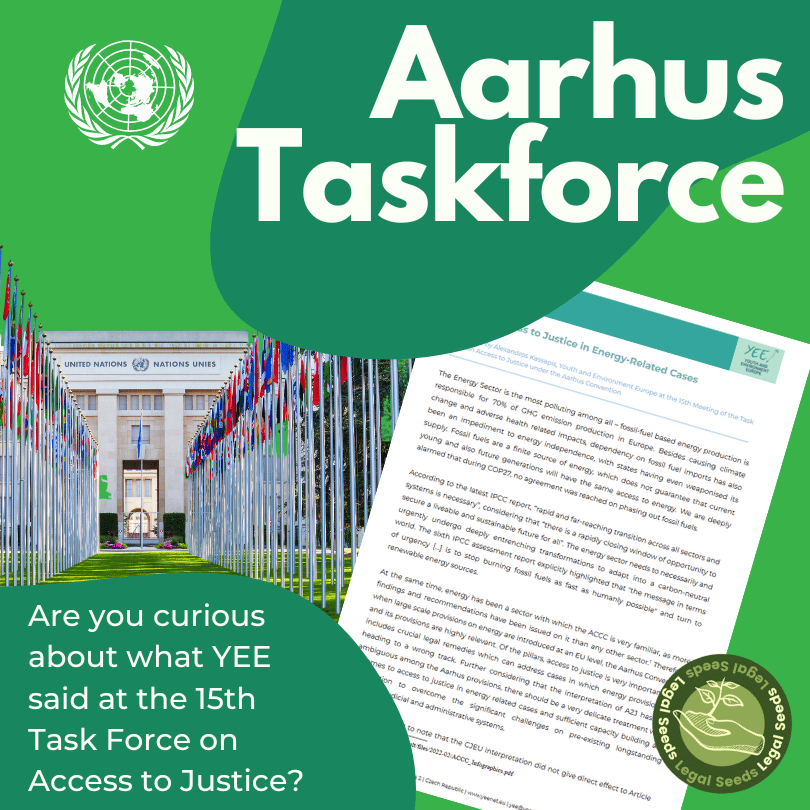
The Environmental Law Team of YEE actively participated in the 15th Task Force on Access to Justice in Geneva, sharing valuable insights.

The discussion within the EU around the Fit For 55 legislative package is at the core of the EU’s current action on
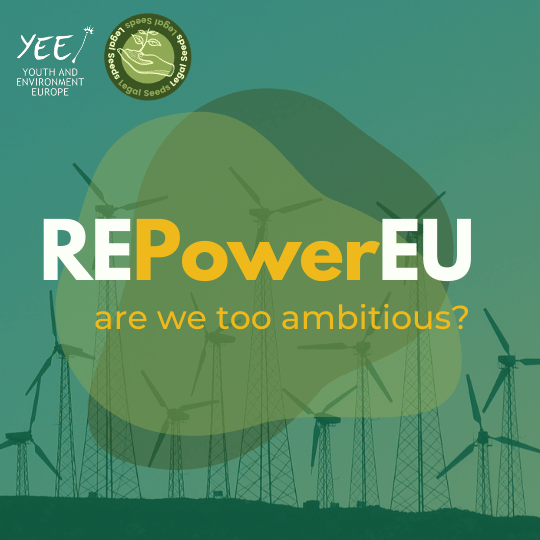
If exiting from the Russian fossil fuels, gas and coal import is a necessity, should it be then done at all costs?
More To Explore
Advocating for stronger legal protection of rivers in Europe
https://yeenet.eu/wp-content/uploads/2023/05/1-3.png 810 810 YEE https://yeenet.eu/wp-content/uploads/2018/11/logo-yee-728x1030.png YEE2023-05-18 09:44:322023-06-23 09:17:11Advocating for stronger legal protection of rivers in Europe
Written by
Haguar Mourad
Contents
Visual summary



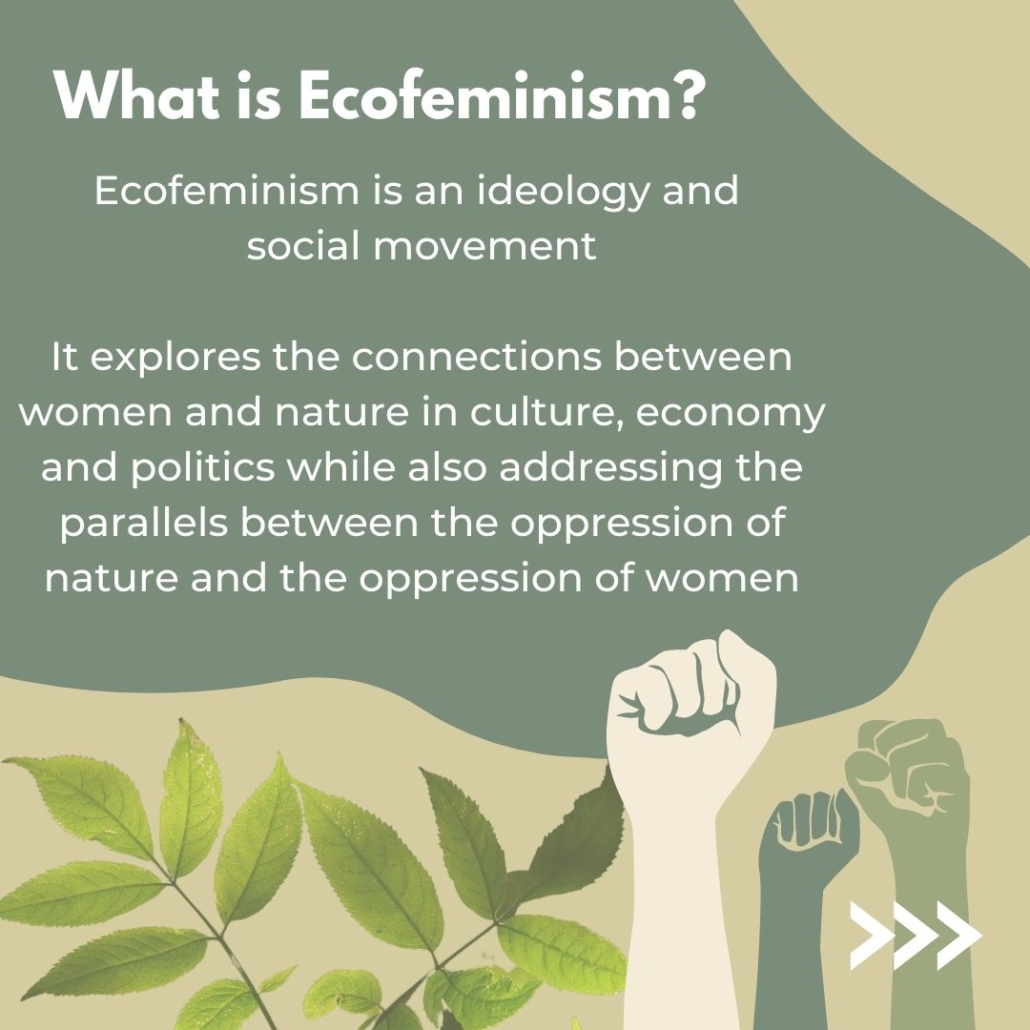

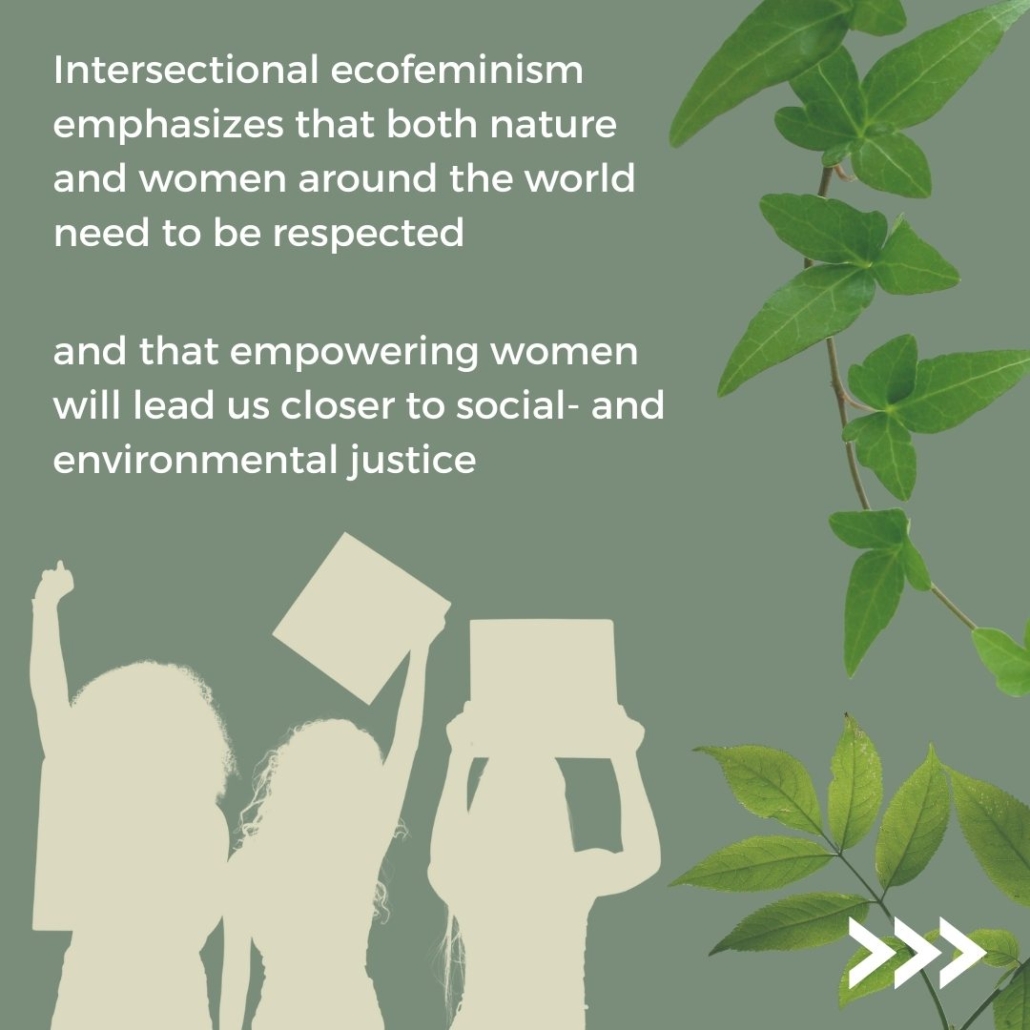
Share this article
“We are either going to have a future where women lead the way to make peace with the Earth or we are not going to have a human future at all.” – Vandana Shiva.
Many women have been remarkably stepping into environmental advocacy spaces to make their voices heard, but how important is it to integrate both feminism and climate activism in our advocacy discourse?
We have all heard activists and seen studies claim that women lead better and are peacemakers as they favour intuition and collaboration, so, could ecofeminism really be the ultimate solution for the environmental debacle we are facing?
The birth of ecofeminism
As we all may know, women are one of the main groups that are at the frontline of climate activism since they are particularly affected by the environmental crisis (80% of the people being displaced by climate change are women according to UN Environment), which is why special attention towards women and the climate change effects on them is needed. This is notably explored by ecofeminism.
The term ‘ecofeminism’ was first coined by the renowned French feminist Françoise d’Eaubonne, who described it to be a branch of feminism that explores the connections between women and nature. What is also interesting about Ecofeminism is that it digs deeply into how both women and the environment are at risk as a result of the patriarchal rule. As a matter of fact, patriarchy has always been strongly linked with capitalism which explains the simultaneous exploitation of both natural resources and women as a social class.
Some not-so-fun facts worth mentioning are that 70% of the 1.3 billion people living in conditions of poverty are women. In urban areas, 40% of the poorest households are headed by women. Women predominate in the world’s food production (50%-80%), but they own less than 10% of the land.
Ecofeminism is believed to be more respectful of nature and women as it decenters males and abolishes hierarchies, men are then not thought to be superior to women or nature. Although ecofeminism originated in Europe, the actual movement started in the USA during the late 1970s and early 1980s, where it took a more inclusive turn as it coincided with the rise of intersectional feminism. Intersectional ecofeminism holistically plunges into the living conditions of women from different backgrounds and dissects the inequalities they endure through an environmentalist lens. It is then considered to be the ideal activistic paradigm.
Why intersectionality is a necessity
While addressing the struggles of women in the context of climate change, the term “women” tends to be vague as they are not a homogeneous group, they actually exist on a large spectrum that should be meticulously analysed hence the need for an intersectional approach.
Intersectionality sheds light on different issues faced by various women, such as the different geographical contexts. As a matter of fact, women face different challenges based on where they’re from. For example, in areas that are prone to droughts, women often face different struggles than men. Environmental degradation such as droughts often leads to economic instability, and as a result, women may have to give up on resources such as education in order to support the family.
Ecofeminism recognises how gender roles make us experience our environment and nature differently, and how different gender roles may experience different consequences. Another example is how women in some contexts are forced to travel long distances to collect fuel, food, and water which subjects them to security risks and gender-based violence. Moreover, in Mexico and Central America between 2016 and 2019, about 1,698 acts of violence were recorded against female human rights defenders.
Different journeys equal different constraints
All struggling communities should then be provided with a platform that allows them to speak up about their experiences and share their stories that are a testament to their resilience. We can never do justice to the representation of the different journeys led by different women in the context of climate change, however, the best we can do is to make their names known, especially the non-white and underrated ones like Isatou Ceesay, Vandana Shiva, Susan Chomba, Sônia Guajajara and many others.
Going back to the initial question, women have the ability to make this world a better place: they are the backbones of their communities and the shapers of the future that we can’t overlook the importance of their role in eradicating the climate crisis, empowering them locally and globally could definitely revolutionise our dystopian foreseeable future.
So, if you were to envision a non-patriarchal world where women were predominantly leaders, don’t you also think that our history and present would have been vastly different?
Recommendations
If you want to explore this topic more, check out the podcast “Outrage + Optimism”, episode number 191.
More articles

The war in Ukraine has highlighted the significance of energy policy as a major power issue. It is an opportunity to break

How is our generation responding to the challenges posed by the energy crisis and the imperative for a green transition? This thought-provoking
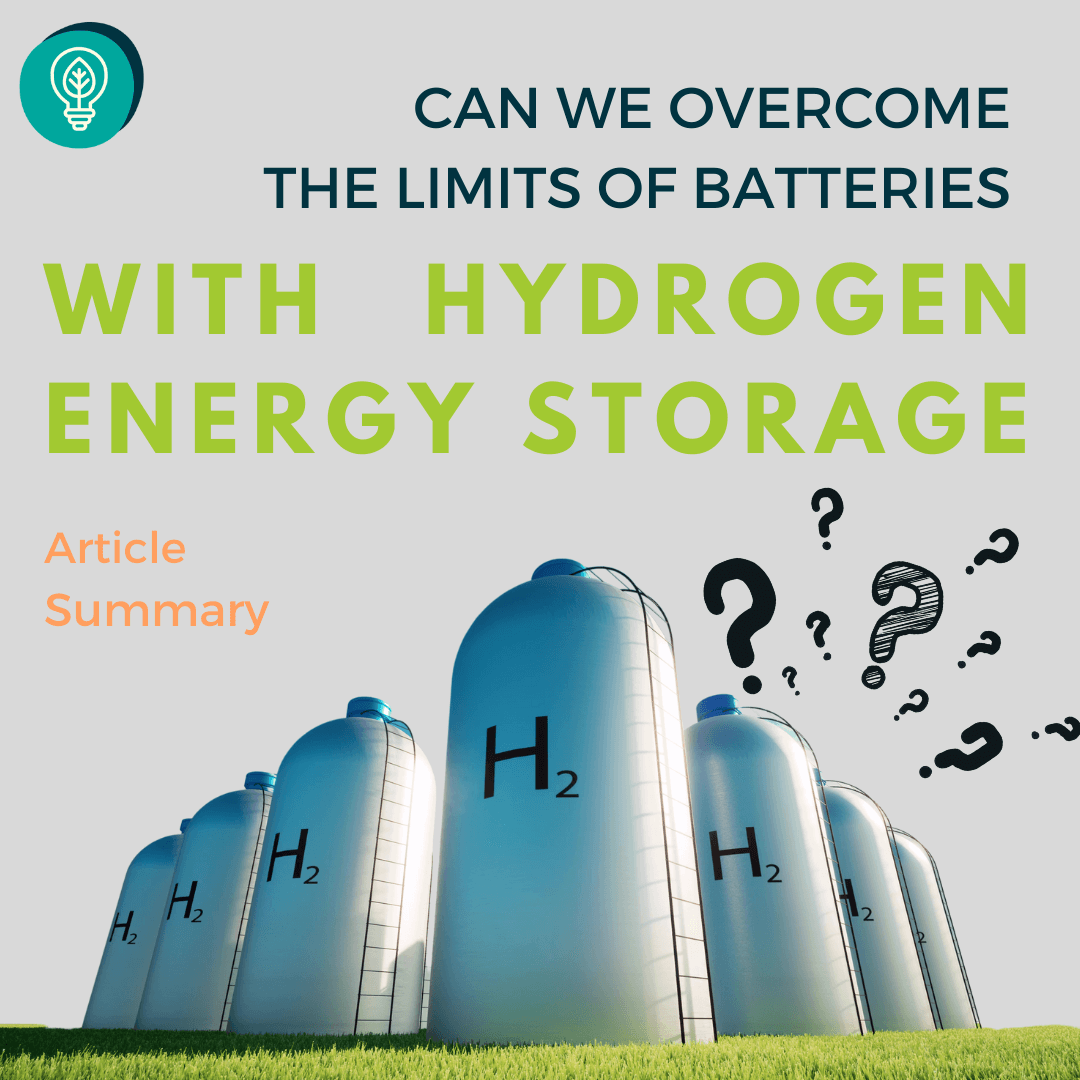
In this article, we will delve into the exciting world of hydrogen as a potential solution for energy storage, aiming to overcome

Learn about the positive and negative outcomes of the liberalisation process, and how energy communities could play a major role in the
Intersectional Ecofeminism
https://yeenet.eu/wp-content/uploads/2023/05/1.jpg 1080 1080 YEE https://yeenet.eu/wp-content/uploads/2018/11/logo-yee-728x1030.png YEE2023-05-04 12:43:002024-02-22 16:39:20Intersectional Ecofeminism
The Environmental Law Team of YEE participated in the 15th Task Force on Access to Justice, which took place in Geneva from 4 to 5 April 2023. During the meeting, Emma and Alex delivered their statements, contributing to the exchange of information and best practices regarding the implementation of the Aarhus Convention’s access to justice pillar.
The purpose of the meeting was to facilitate the exchange of information, experiences, and best practices related to the implementation of the Convention’s access to justice pillar. The focus of the meeting was on access to justice in cases concerning climate change and biodiversity protection, with discussions covering current trends, barriers, challenges, good practices, and innovative approaches in these areas.

Summary of Emma’s statement regarding the tools to promote Access to Justice
The latest IPCC report emphasizes that climate change will mainly impact children and young people, highlighting the need for long-term considerations and intergenerational equity in environmental legislation. Young people also face challenges in exercising their rights under the Aarhus Convention. The Aarhus Convention is important for environmental democracy, granting the public rights in environmental matters to protect the rights of present and future generations. Strengthening multi-stakeholder dialogue can ensure easier youth access to decision-making processes and hold institutions accountable.

Summary of Alex’s statement regarding Access to Justice in energy-related cases
Dependency on fossil fuel imports hampers energy independence and is finite, posing a threat to future generations. The Aarhus provisions play a crucial role in ensuring that energy supply in the EU has a positive impact on nature and communities. However, legislative proposals may impede access to justice in energy-related cases, prioritising renewable energy development over environmental protection and community engagement. The Aarhus rights, including access to justice, play a crucial role in promoting renewable energy, environmental protection, and public participation.
Learn more about the Aarhus Convention
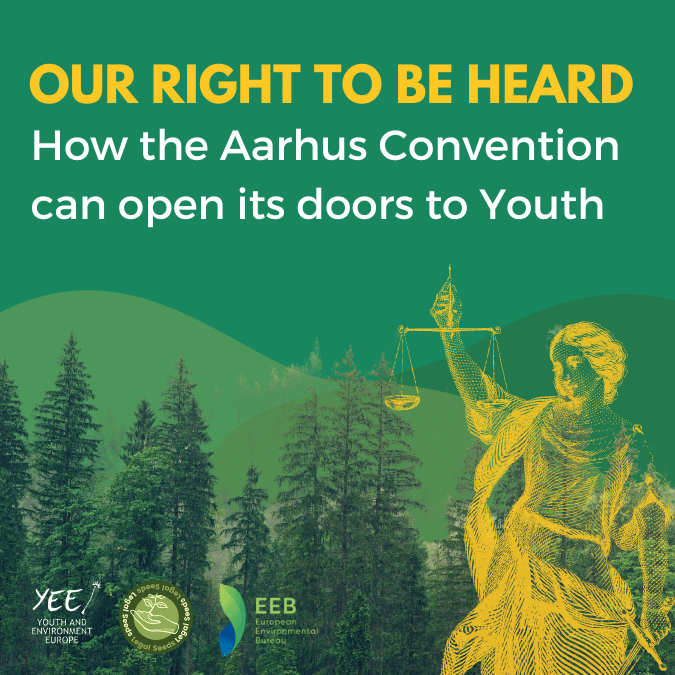
Why Aarhus State Parties fall short of their obligation to guarantee the right to public participation of young people in environmental decision-making?
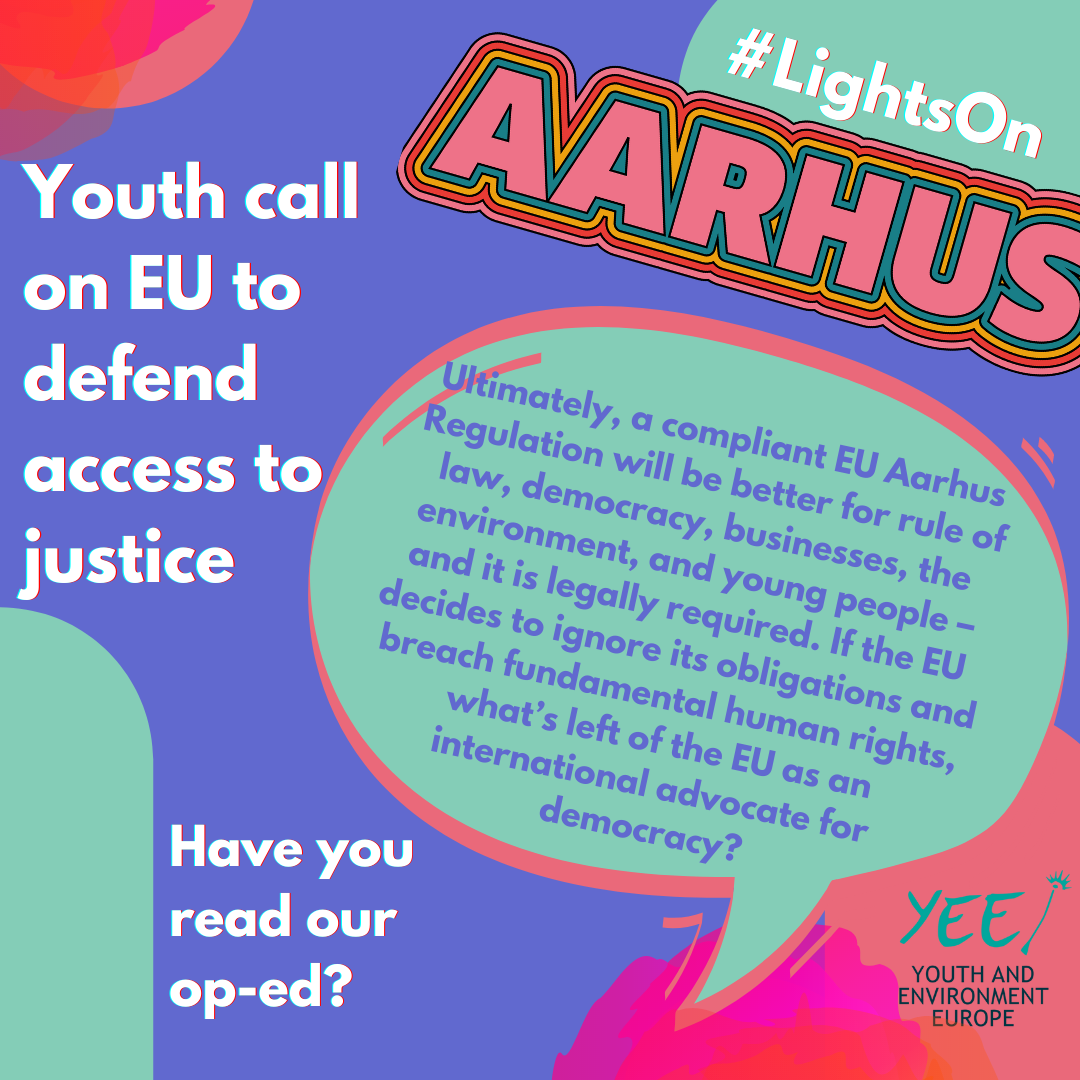
The EU is in breach of its obligations under the Aarhus Convention. Young people all over Europe are joining civil society organizations
More To Explore
15th Task Force on Access to Justice | Statements of the Environmental Law Team
https://yeenet.eu/wp-content/uploads/2023/08/15th-Aarhus-Taskforce-Access-to-Justice.png 810 810 YEE https://yeenet.eu/wp-content/uploads/2018/11/logo-yee-728x1030.png YEE2023-05-01 14:40:002023-08-01 15:22:3315th Task Force on Access to Justice | Statements of the Environmental Law TeamPractical information
-
When
Friday 17th April 2023 at 17h CEST
-
Where
Online
-
How
Register your interest
Share This Event
Are you interested in knowing more about the European energy policy?
About the experts

Chris Vrettos is leading a project designed to help Member States assess whether their national funding programs (Cohesion Funds, Modernisation Funds, Recovery and Resilience Funds) are dedicating specific funds towards energy communities and if this is done in line with EU legislation.

Paul Ségalard has a degree in Energy and Climate law and is the leader of the Ampower project at YEE
Did you miss this webinar?
Download the presentations or read our recap and learn more about the European energy policy and energy communities!
Have questions? Get in touch!
Other upcoming events
European energy policy | Webinar
https://yeenet.eu/wp-content/uploads/2023/04/Webinar-Energy-Policy-Instagram-Post-Square1.png 810 810 YEE https://yeenet.eu/wp-content/uploads/2018/11/logo-yee-728x1030.png YEE2023-04-06 16:57:192023-05-23 12:30:49European energy policy | Webinar
COP27 Reflections - Together for implementation?
COP27 wrapped up after negotiations which continued far into the night in the last days of the conference in Sharm el-Sheikh. Despite some positive outcomes, such as the Loss & Damage fund, there is still a lack of recognition of the need to phase out fossil fuels and a general lack of ambition. The motto for this COP was “Together for Implementation” – but have we been able to pass it to action? And are the parties truly “together” in the face of the climate crisis?
Critiques have been heavy so far: Frans Timmermans, EU Climate Policy Chief, addressed the COP: “I urge you to acknowledge when you walk out of this room, that we have all fallen short in actions to avoid and minimise loss and damage. We should have done much more, our citizens expect us to lead.” His conclusions are humbling: “This is the make or break decade, but what we have in front of us is not enough of a step forward for people and planet.”
A year on from COP26, we are faced with the same issues and discussions. COP26 president, Alok Sharma, recalled: “I said in Glasgow that the pulse of 1.5 degrees was weak. Unfortunately, it remains on life support. And all of us need to look ourselves in the mirror and consider we have fully risen to that challenge of the past two weeks.” 1.5 is still the rallying cry from civil society, but it seems an air of resignation could be felt: we aren’t set to keep to this target.
As young people, acutely aware that this is our future being decided, it is frustrating to feel that ambitions are being lowered – but the silver lining: at least there was no backsliding on resolutions made in Glasgow. The reality is that climate diplomacy, based on consensus, will be slower and more conservative than the action and words we see on the ground.
This was YEE’s second COP and this year, YEE was able to send two delegations, allowing for a rotation each week. With 11 young people from Europe over the course of a fortnight, we had a diversity of roles and perspectives. As our delegate Adéla said: “Although I participated in multiple calls and trainings about negotiations, COPs and UNFCCC, I believe there is no better way to prepare yourself for it than just experiencing it right on the spot.” No matter our feelings on the outcomes and the events at COP, it is undeniable that as young people it is incredibly empowering to be able to attend such high-level events.
A space for young people?
It could look like that young people were finally given a proper space at COPs when the Youth & Children Pavilion was announced earlier this year.
However, as the head of week 2 delegation, Agnes, reflects, it was not exactly what we were hoping for:

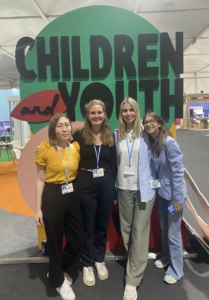 Nonetheless, there were many young people at COP that we were able to connect and coordinate with – a partnership building which resulted in a collective push for the phasing out of fossil fuels at the EU level. As our delegate Timea said: “I think young people did their best at this COP to make a powerful impact on progressing climate action. The Children and Youth Pavilion was always filled with an audience, having interesting events and influential speakers.” The value of young people’s contributions did not go unnoticed.
Nonetheless, there were many young people at COP that we were able to connect and coordinate with – a partnership building which resulted in a collective push for the phasing out of fossil fuels at the EU level. As our delegate Timea said: “I think young people did their best at this COP to make a powerful impact on progressing climate action. The Children and Youth Pavilion was always filled with an audience, having interesting events and influential speakers.” The value of young people’s contributions did not go unnoticed.
A step forward on Loss & Damage
The most positive outcome of COP was undoubtedly the announcement of a Loss and Damage fund, after years of advocacy from the Global South. Especially Small Island States and other countries particularly hit by climate change have been using COPs to highlight the need for measures to support efforts to adapt to this new reality and finance the costs caused by the climate crisis. This is sometimes understood as ‘climate reparation’. While the details of this fund, who will pay and what amount, are yet to be decided, it is a historic move which will reopen the conversation of responsibility surrounding climate change. Will it be based on historic emissions and responsibilities? A question of a country’s development status? The EU’s Frans Timmermans argues: “I think everybody should be brought into the system on the basis of where they are today… China is one of the biggest economies on the planet with a lot of financial strength. Why should they not be made co-responsible for funding loss and damage?” The current list of developing vs developed countries used in negotiations is based on a UN determination from the 1990s. We will have to watch and see how the Loss & Damage fund puts in question responsibility and who will end up contributing to the fund.
Given the focus of this COP on implementation, and therefore adaptation, this result can definitely be seen as a step forward. Yet there is more adaptation needed if we don’t keep acting on mitigation. This implementation plan did not include the phasing out of fossil fuels – an essential step for climate change mitigation. Keeping 1.5 °C alive has never felt more precarious.
Organising side-events
As civil society, one of our best opportunities was to organise and host side-events. In week 1, in partnership with the European Environmental Bureau and the International Foundation for African Children, we organised an Intergenerational Dialogue on Climate-Induced Migration in the framework of adaptation. We were able to bring together a diverse range of figures from H.E. Nduwa Mkaka, the Minister of Natural Resources and Climate Change of the Republic of Malawi, to Koko Warner the, Manager of the Impacts, Vulnerability, & Risks Sub Programme at UNFCCC, and Sinziana Puscas, a Climate Change and Migration Specialist from the International Organisation on Migration (IOM).
Overall, we were able to have a moment of exchange on what we believe to be an essential topic when considering implementation and adaptation. We were also able to host a UNFCCC-approved protest in the Blue Zone at the end of Week 1 – calling for the protection of environmental defenders and denouncing the fact that multiple countries view environmental defenders as criminals. Studies have found that between 2012 and 2022, more than 1700 environmental activists have been murdered or gone missing. This felt particularly pertinent in the political context of Egypt.
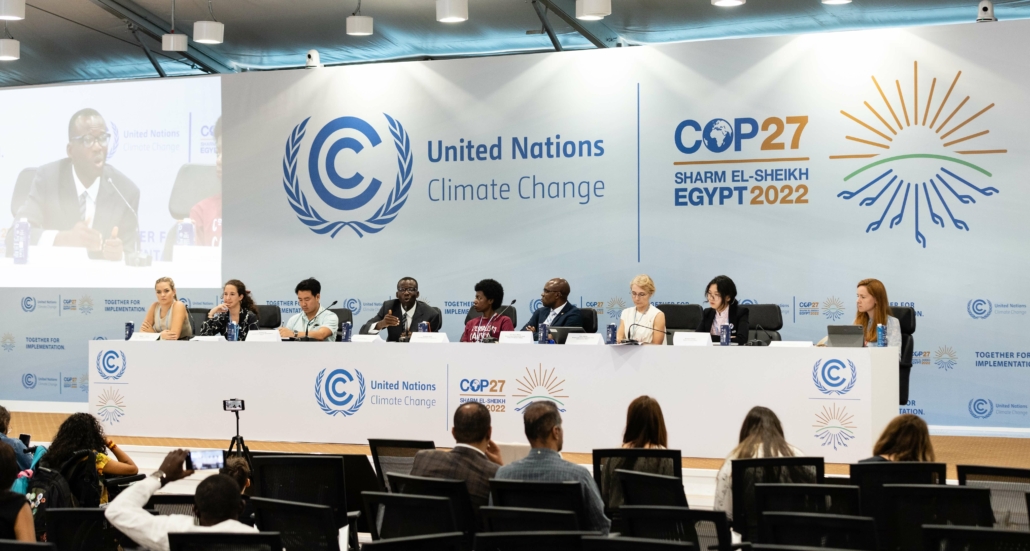
In the second week, we organised a networking session on intergenerational equity in the Youth & Children Pavilion where we shared our frustrations about youth involvement, or rather the lack of it, in the decision-making processes with Dr. Christina Voigt, the Chair of the IUCN World Commission on Environmental Law (WCEL), who was part of the negotiations as an academic. Dr. Voigt stated: “If you ask, what is intergenerational equity, my answer is, that is what is missing at COP.” Overall, these side-events were very meaningful to our experience at COP – a definite challenge but fruitful.
A challenging experience overall
There was no shortage of challenges at COP – from the pure stressful environment of thousands of people milling around hundreds of pavilions to the pressure felt at being a young person in such a professional and intimidating space.. A key hardship our delegates felt was the frustrations and disappointment at what was being said in negotiation spaces.
As Sophia recounted:
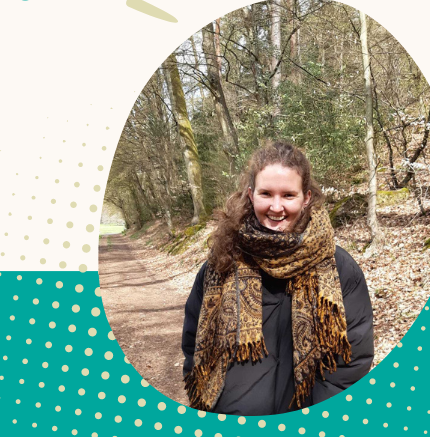
And this is when we were able to access these spaces: our observer badges did not guarantee full access. This resulted in a “lack of transparency of negotiations (which) further deepened our anxiety. Not only did we have no access to negotiations as Observers, but also there were no newsletters or other reliable sources to follow how the negotiations were going” said our delegate Timea.
The political context was also particular. Our head of delegation for week 1, Pegah, described how “everyday, our team was concerned about what to say and what not to say, so they do not put themselves or their team in danger”. Our Strategic Communications Officer, Chloé, agreed: “Mincing your words, when you are meant to be part of civil society, is counterintuitive.” We will be publishing more thoughts on this particular aspect of COP27 soon.
Finally, the very setting of COP27 in Sharm el-Sheikh caused “cognitive dissonance” as Chloé affirmed. Adéla described how

Two weeks for learning and inspiration
It’s easy to fall into feelings of stress and frustration at COP, all well-founded. It is a challenging environment for anyone – from a young climate activist to a seasoned diplomat. But it is clear that there are some positive aspects to these huge events that gather climate professionals and civil society from all four corners of the globe. Firstly, it’s a steep learning curve. Timea articulated this: “I learnt a lot, exchanging with youth coming from different regions and realities, as well as with experienced policy-makers and experts… It gave me a lot of motivation and hope to see young people working together, fully committed for a better future”.
“It is so uplifting to find yourself surrounded by people talking as passionately (or more passionately) about your interests day in and day out: a continuous reminder that I have so much to learn” agreed our Strategic Communications Officer, Chloé. Overall, it is about seizing the opportunity as Anna affirmed “COP can be a great source of inspiration for those who seek it.”
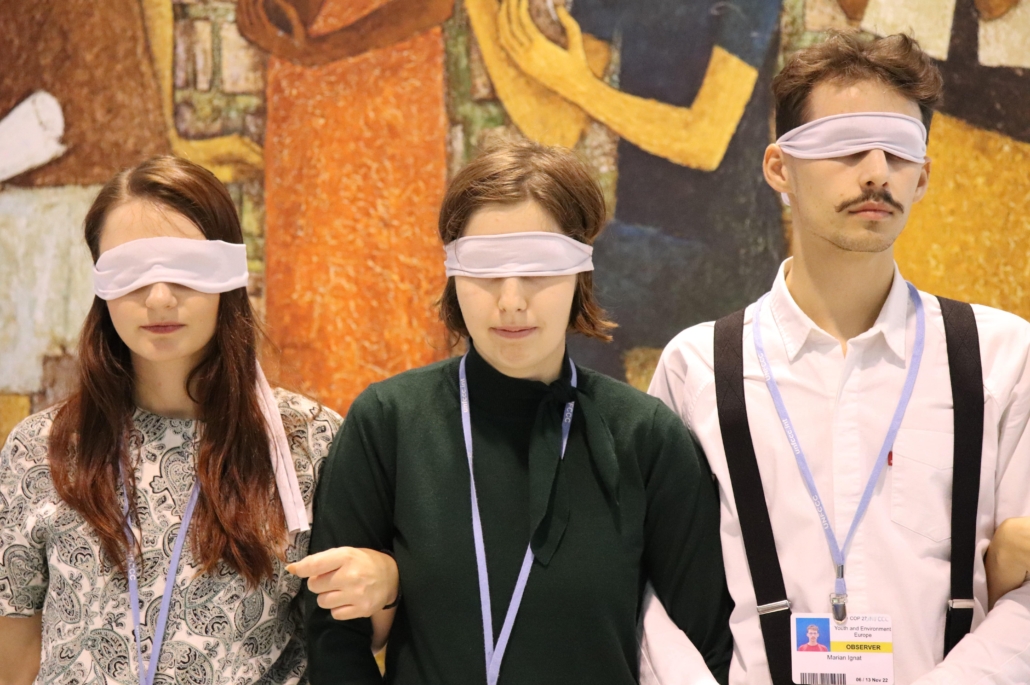
Hope was not eclipsed by despair – “Even in this desert of frustration, there are still islands of hope. I joined a loss and damage climate strike and had an opportunity to speak or even yell from the heart and I met many young climate activists who are so passionate and wholehearted, so I dare to hope that our future is in safe hands” stated our delegate Aleksandra.
Some of the outcomes inspired optimism, our head of delegation for Week2, Agnes, described how “after reading the final decision of COP27, I felt the spark of a small victory by the explicit mention of the role of youth in addressing climate change and the encouragement towards including youth representatives in the climate negotiations.”
Eva, our Communications Manager, attested that “after spending the week at the conference, hearing some great speeches, seeing some great work from experts, and observing many protests, I might hesitantly agree that it is actually our best shot at doing anything about the climate crisis on the global scale. By saying this, I am however not trying to excuse the greenwashing, the inaction, the obvious business interests, the propaganda of the organisers.”
Overall, there’s no easy way to summarise being a young person at such a high level event, as our delegate Marian said:
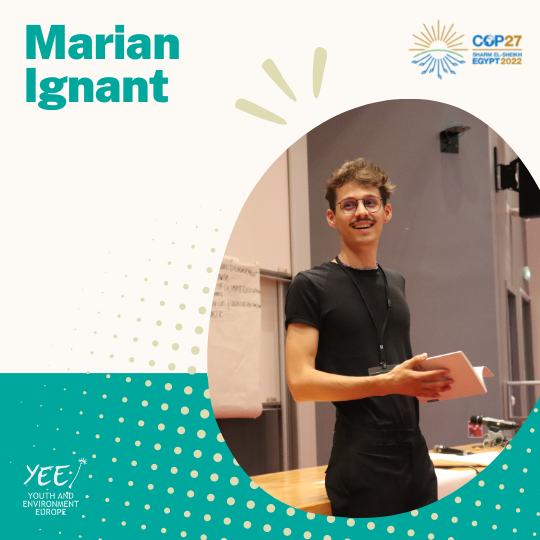
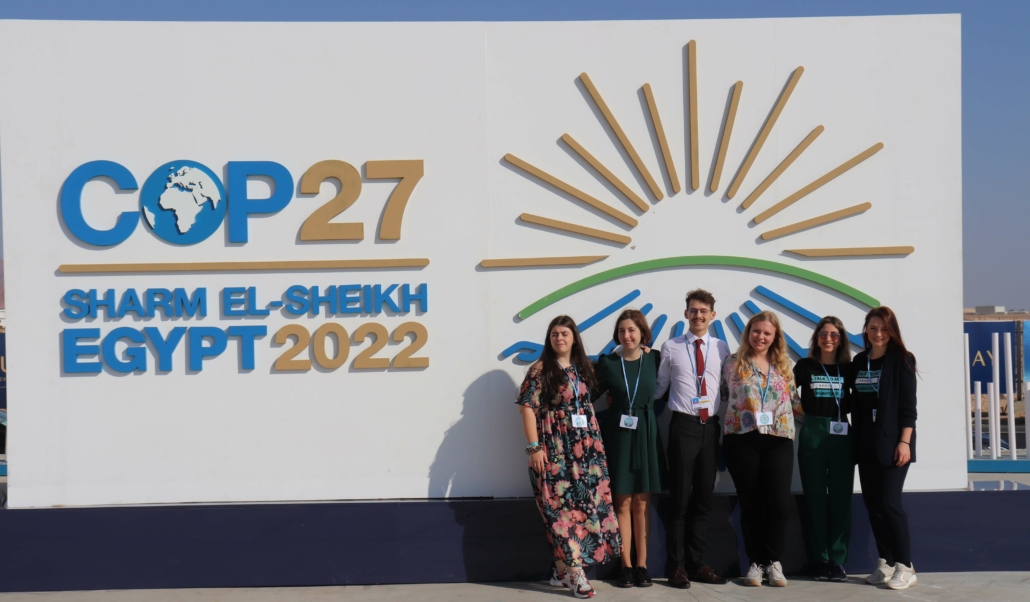
COP27: A breakthrough on climate damages, but still far to go – European Climate Foundation
A Tale of Sand and Power at COP27 – Ecosprinter, Federation of Young European Greens
BREAKING SILENCE ON CLIMATE AND SOCIAL INJUSTICE AT COP27 – Meta, European Environmental Bureau
Statement by President von der Leyen on the outcome of COP27
COP27: Key outcomes agreed at the UN climate talks in Sharm el-Sheikh – CarbonBrief
EU opens the door to a loss and damage facility – if China pays – Climate Change News
As you read the full reflections written by our delegates, please keep in mind that when some of us who attended just week 1 started to reflect on our experiences, the negotiators are meant to be wrapping up negotiations and preparing for the publication of final statements. Therefore tone or references made may not be up to date.
COP27 Reflections – Together for implementation?
https://yeenet.eu/wp-content/uploads/2022/12/Reflection-Post.png 540 540 YEE https://yeenet.eu/wp-content/uploads/2018/11/logo-yee-728x1030.png YEE2022-12-07 12:01:052023-03-31 15:02:05COP27 Reflections - Together for implementation?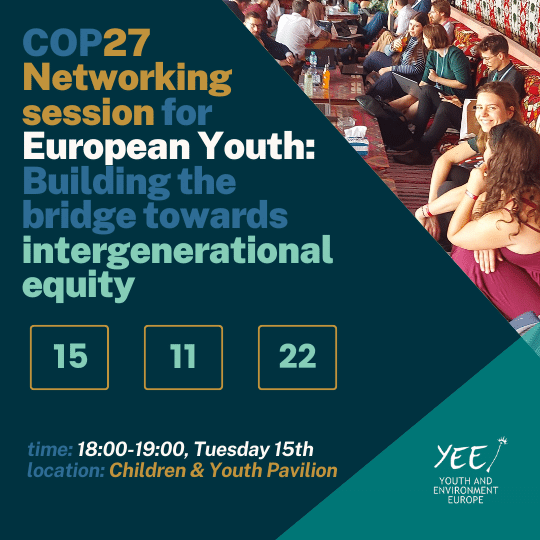
Networking session for European Youth: Building the bridge towards intergenerational equity | COP27 Side-event
https://yeenet.eu/wp-content/uploads/2022/11/Week2-COP27-Side-EVent-Save-the-Date2.png 540 540 YEE https://yeenet.eu/wp-content/uploads/2018/11/logo-yee-728x1030.png YEE2022-11-13 08:02:352023-03-31 15:02:07Networking session for European Youth: Building the bridge towards intergenerational equity | COP27 Side-event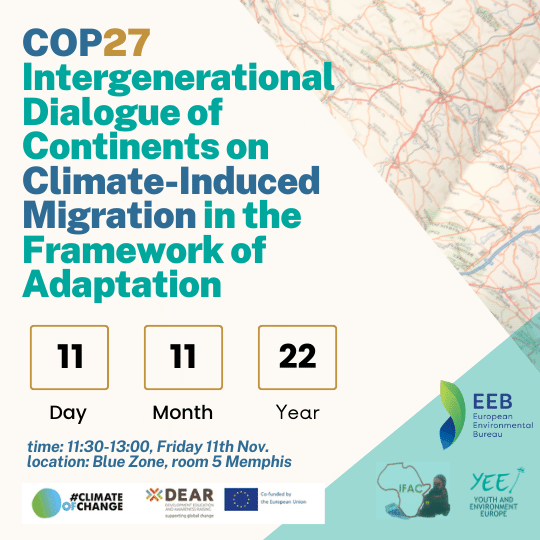
Intergenerational Dialogue of Continents on Climate-induced Migration | COP27 Side-event
https://yeenet.eu/wp-content/uploads/2022/11/COP27-Side-EVent-Save-the-Date.png 540 540 YEE https://yeenet.eu/wp-content/uploads/2018/11/logo-yee-728x1030.png YEE2022-11-03 14:35:522023-03-31 15:02:08Intergenerational Dialogue of Continents on Climate-induced Migration | COP27 Side-eventEnergy crisis and ecological emergency: is the REPowerEU plan THE solution?
Author: Mathilde Angeledei
Following the Russian invasion of Ukraine on the 24 of February 2022, the European Union faced a lack of gas distribution from Russia due to its support to Ukraine in the conflict. In reaction, the European Commission presented on March 8 the idea of coming up with a new project which aims at phasing out Russian fossil fuels and becoming more autonomous and independent regarding its energy supply and security. The plan was well received by EU leaders, who signed the Versailles declaration. They all agreed on the necessity to make the EU independent from Russian energy imports as soon as possible. On May 18, the Commission presented the REPowerEU plan and a week after the EU Energy Platform Task Force was established to secure alternative supplies.
The REPowerEU plan sets out a series of measures to rapidly reduce dependence on Russian energies by developing new energy cooperation agreements while investing in its own green transition.
The REPowerEU plan moves around three main areas:
Energy savings & reduction
Firstly, rather than waiting for an alternative solution to Russian energy, the EU prefers to count on energy savings from its own citizens and companies. Saving energy is the cheapest, safest and cleanest way to start the REPowerEU plan. The Commission wrote five simple daily life guidelines for EU citizens to follow:
- reducing heating temperatures or using less air-conditioning;
- using household appliances more efficiently;
- driving more economically;
- shifting to more public transport and active mobility;
- switching off the lights.
This is in line with the Commission’s objective to save around 13 bcm (billion cubic meters) of gas import by relying only on citizens’ and businesses’ responsible behavior.
In the long term, the Commission wants to boost industrial decarbonisation with €3 billion of frontloaded projects under the Innovation Fund and increase its ambition on energy savings by raising the EU-wide target on efficiency for 2030 from 9% to 13%.
On top of that, the EU demands a reduction emergency plan in case of gas supply disruption.
Alternative Energy Supplies
Secondly, the EU is working with international partners such as Israel and Egypt to find alternative energy supplies.
In the short term, the EU needs alternative supplies of gas, oil and coal and it is exploring the future of renewable hydrogen too.
In the long term, the EU will invest in an integrated and adapted gas and electricity infrastructure network. Moreover, the EU is currently writing a proposal to ensure the industry has access to critical raw materials.
Renewables
Thirdly, for the quantities the Member States still need to consume, the goal is to replace it with renewable energies. Many short and long-term measures have been proposed by the Commission.
Concerning short-term measures, the EU wants to increase the production of biomethane to save 17 bcm of gas imports and intensify solar and wind energy projects to save around 50 bcm of gas imports
Concerning long-term measures, the EU wants to modernize and simplify the legislation on renewable energy such as wind turbines and solar panels to enable a rapid issuance of building permits at low environmental risk. One of the most ambitious projects of the EU is to build a 17.5 GW hydrogen accelerator of electrolysers by 2025 to fuel the EU industry with homegrown production of 10 million tonnes of renewable hydrogen.
Why is the REPowerEU plan problematic?
If exiting from the Russian fossil fuels, gas and coal import is a necessity, should it be then done at all costs? This ambitious REPower EU plan will challenge the EU more than any other plan before. Indeed, this plan should combine a rapid transition to decarbonised energy with the building of strong partnerships between democratic countries while keeping energy affordable and secure for all citizens.
Switching off the light is common sense
The first objective of the project is saving energy, however, it seems clear that asking citizens to reduce energy is a tough job. Electric devices, especially cars and home technologies have increased this last decade, intensifying the need for energy. The solutions offered by the EU have already been implemented in people’s minds for years. Switching off the light when leaving a room is common sense, the same as using less air-conditioning. In the short term period, the EU needs to focus on industries and administration offices to save energy because they are the first consumers of energy and are most able to establish plans to reduce their energy consumption.
Renewable energy overlooked concerns
For many countries, it is still difficult to envisage such a quick transition at a time when energy prices are causing public anger. An abrupt halt to Russian imports combined with a forced installation of renewable energy facilities will make the working classes, already hard hit by the energy crisis, even more insecure.
The main objective of the EU is to become independent by investing in renewable energy. However, the creation of an energy park based solely on renewable energies requires several years of discussion and implementation. It will also require strong cooperation between the 27 states and huge financial investments.
In an amendment voted on June 27, the Energy minister of Member States backtracked on the development of renewable energies. The amendment removes the Commission’s push to increase the target for renewables in Europe’s energy mix to 45%, replacing it with the 40% target. This is below both the European Parliament’s and the European Commission’s positions, which both support the 45% target. The amendment also deleted the legal concept of “overriding public interest” for renewable energies. If adopted, the principle would help protect new renewable projects against legal challenges. Although unanimously welcomed, the REPower EU plan seems in fact creating dissension among the 27.
Another hurdle concerns renewable energy in the EU. When talking about renewable energy, the issue of rare metals is often overlooked. Europe is not a producer of these precious metals. A rapid and brutal change in its energy policy risks putting it once again at the mercy of the countries producing these rare metals, such as China.
Moreover, the environmental impact of the extraction of these rare metals is an issue. Often criticized, their extraction is a source of significant pollution for the ecosystems.
Human rights
Concerning the objective of diversifying imports of energy, the EU concluded new agreements with Egypt, regarding the import of hydrogen; and with Azerbaijan, regarding the import of fossil fuels and gas. If these agreements allow the EU to diversify our sources of energy, they are, however, rooted in cooperation with countries that are often criticized for their respect of human rights. For more than two years, the war between Armenia and Azerbaijan over the Upper Karaba has already caused several thousand deaths. If the EU wants to put an end to Russian energy imports for ethical reasons, it should not be at the expense of other populations.
In conclusion, the REPower EU Plan, born from a very laudable desire to move away from a harmful dependence on Russian energy, does not seem to take the necessary time to prepare a prosperous transition for all.
More than ever, European citizens must be aware of their energy impact and do their best to control and reduce it. Last but not least, governments should develop energy efficiency laws for businesses to initiate a general awareness movement to promote more efficient energy consumption.
Energy crisis and ecological emergency: is the REPowerEU plan THE solution?
https://yeenet.eu/wp-content/uploads/2022/11/Repower-EU-article.png 540 540 YEE https://yeenet.eu/wp-content/uploads/2018/11/logo-yee-728x1030.png YEE2022-11-03 12:03:162023-06-23 09:19:11Energy crisis and ecological emergency: is the REPowerEU plan THE solution?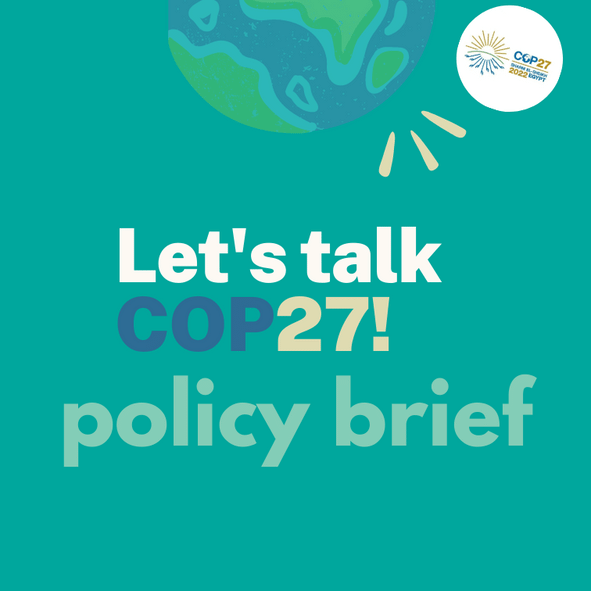
Policy Brief | COP27
https://yeenet.eu/wp-content/uploads/2022/10/COP27-baneers-Square-Sticker.png 591 591 YEE https://yeenet.eu/wp-content/uploads/2018/11/logo-yee-728x1030.png YEE2022-10-27 10:09:122023-03-31 15:02:09Policy Brief | COP27Our mission
 YEE aims to unite environmental youth non-profit organisations in Europe in order to enhance international cooperation, increase knowledge about the climate crisis, raise awareness of environmental problems and to strengthen participation of youth in environmental decision-making.
YEE aims to unite environmental youth non-profit organisations in Europe in order to enhance international cooperation, increase knowledge about the climate crisis, raise awareness of environmental problems and to strengthen participation of youth in environmental decision-making.
Information
Get in touch
Vinohradská 2165/48
120 00 Praha 2 – Vinohrady
Czech Republic
E-mail: yee@yeenet.eu
We are supported by
Supported by the Council of Europe through the European Youth Foundation.
Co-funded by the European Union. Views and opinions expressed are however those of the author(s) only and do not necessarily reflect those of the European Union or the European Education and Culture Executive Agency (EACEA). Neither the European Union nor EACEA can be held responsible for them.




